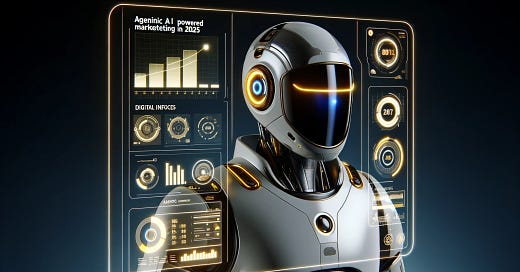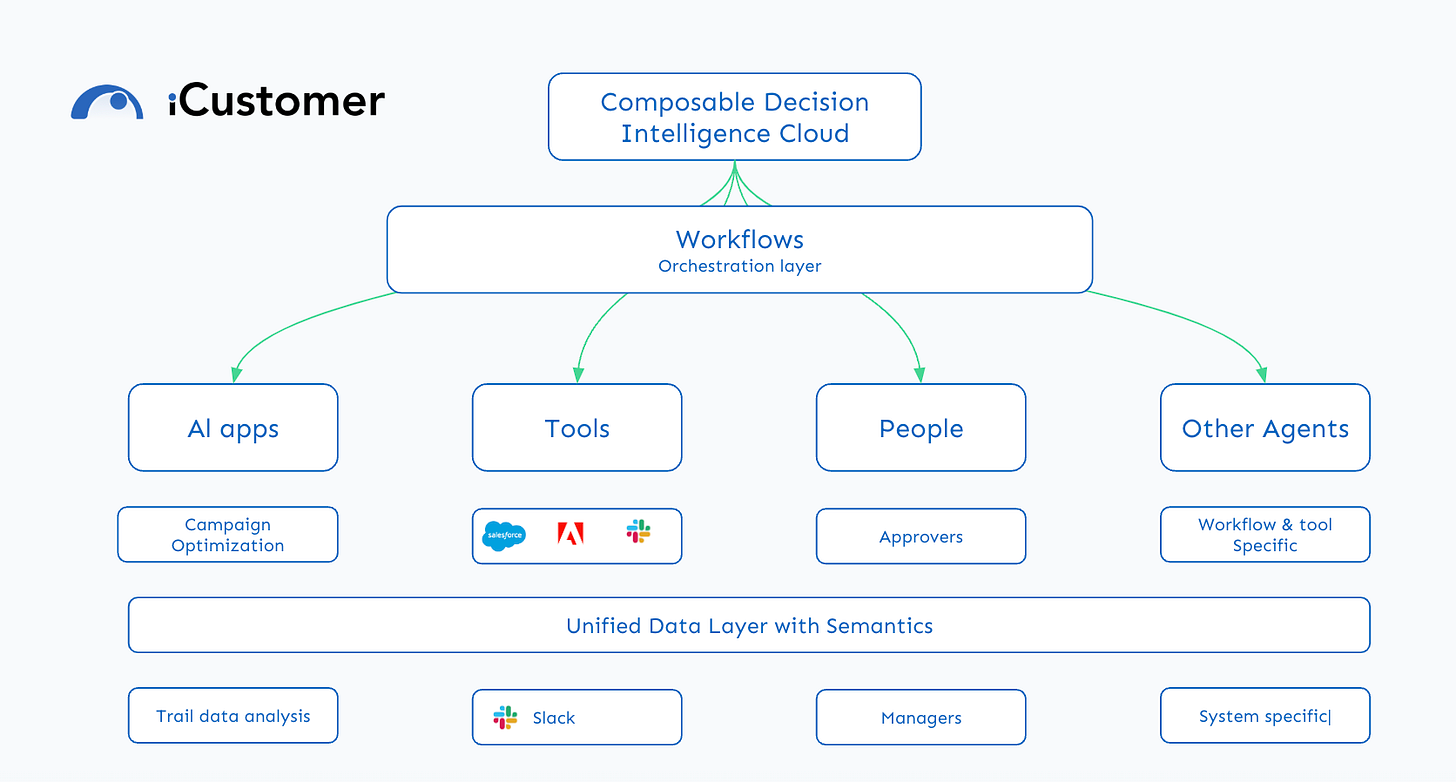Agentic AI: The Next Frontier for Marketing and Customer Data
From passive AI assistants to proactive collaborators: how autonomous AI will transform your marketing strategy & GTM (go-to-market) operations
Look, I've been neck-deep in Agentic AI research for a year plus now, while also building iCustomer and here's what keeps me up at night: while everyone's playing with ChatGPT, Claude and marveling at copy or image generators, the real revolution is brewing just beneath the surface.
If you've been following the generative AI explosion over the past year, you've probably dabbled with AI-powered content creation and maybe integrated a chatbot or two. Cool stuff, sure—but honestly? That's just the warm-up act.
The main event—what I'm now convinced is the actual "next frontier"—is something called agentic AI: systems that don't just answer your questions but take meaningful actions on your behalf, while also observing your data & activities in a “always on” approach. And yes, I've got the receipts to back this up.
I've been combing through reports from Bain, Deloitte, Google, PwC, and even Sequoia (you know, the folks who funded basically every tech company you use), and they're all saying the same thing: we're standing at the edge of something transformative. For those of us working at that messy intersection of customer data, SaaS products, and marketing strategy, this isn't just interesting—it's existential.
What Makes Agentic AI Different? (And Why I'm Actually Excited About It)
So what separates agentic AI from the chatbots or even ChatGPT we're all using? It's the difference between having an assistant who takes notes in meetings versus one who actually orchestrate the meeting, follows up with everyone, and implements the decisions made.
These systems can:
Understand actual business goals—not just "write me a blog post" but "increase our webinar-to-lead conversion by 20% this quarter"
Create strategic plans—I'm talking about systems that will build personalized email sequences, run A/B tests on landing pages, and shift ad spend across channels (things that would take your team days)
Execute tasks on their own, jumping between your CRM, analytics tools, and marketing platforms without human hand-holding
Learn and improve through feedback—adjusting strategies based on what's actually working, not just what worked last quarter
To borrow McKinsey's framing (which I found surprisingly non-jargony): "we're moving from AI that informs to AI that actually does" (McKinsey, 2024). And that's the whole ballgame.
Credit: iCustomer
Why This Changes Everything for Marketing (No, Really)
I know, I know—every tech shift comes with breathless "this changes everything" proclamations. But hear me out.
Sure, your team might already be using AI to crank out social posts or first drafts of blog content. That's great! But it's like using your smartphone just to make phone calls. You're missing the point entirely.
1. Personalization That Actually Deserves the Name
Andreessen Horowitz has this wild prediction about "marketing agents" that can build one-off, targeted campaigns for individual customers. Not segments—individuals. All while analyzing performance and tweaking creative assets in real-time (a16z, 2024).
Picture this: Your AI agent spins up 10,000 ad variations across Instagram, LinkedIn, and Google Ads. It learns which angles hit hardest for each micro-segment, then continuously shifts budget to winners. No bottlenecks, no weekly meetings to analyze performance, no waiting for creative approvals. Just constant optimization.
Is that overkill? Maybe today. But in 18 months? It'll be table stakes.
2. Go-to-Market Cycles That Don't Make You Want to Cry
I've lived through countless product launches, and the worst part is always the same: the agonizing time between "this is ready to announce" and actually getting the damn campaigns built.
By automating everything from audience segmentation to lead routing, agentic AI could collapse what takes weeks into days. Instead of your team manually configuring each campaign element, imagine saying: "Launch our enterprise security feature to IT directors at companies with over 1000 employees." Then watching an AI agent assemble your entire funnel, run small tests, and scale what works.
The first time you experience this, it'll feel like cheating. Then it'll just feel normal.
3. Always-On Engagement (Without Burning Out Your Team)
Here's something I've never admitted publicly: I've totally dropped the ball on timely marketing opportunities because my team was swamped with scheduled campaigns. We've all been there.
Now imagine a marketing agent that monitors social channels, competitor moves, and industry news 24/7. When something relevant pops up, it shifts messaging or launches micro-campaigns instantly.
Deloitte calls this "perpetual optimization" (Deloitte, 2025). I call it "finally being able to compete with brands that have 10x your headcount."
Real talk: The shift toward autonomous campaign management isn't just coming—it's already happening in pockets. And it might finally deliver the scale and precision that most of us have only dreamed about.
The SaaS Question Everyone's Tiptoeing Around
At every conference I've attended this year, there's a question people ask in private but rarely on stage: "Will agentic AI kill SaaS?"
My take? No—but it's going to force a serious evolution. Here's how I see it playing out:
Service-as-a-Software (The Model Flip)
Both Sequoia and a16z are talking about a coming era where AI directly handles work that previously required expensive services—whether in-house or outsourced (Sequoia, 2024; a16z, 2024).
Think about it: Instead of paying monthly for marketing automation platforms that still need humans to operate them, you might pay an AI agent based on outcomes. $X per qualified lead generated or $Y per campaign executed. The software becomes the service.
For buyers, this is a dream: true value-based pricing. For SaaS companies? A pricing and packaging nightmare.
SaaS Companies Racing to Add Agents
I've had backstage conversations with folks at Salesforce, HubSpot, and Microsoft. They're all scrambling to build "agentic layers" into their platforms. Salesforce Agentforce who announced this last year Dreamforce about Agentforce and 10,000 agents already built so far.
The goal is simple: Let you say something like, "Launch a drip campaign targeting CFOs in manufacturing who downloaded our whitepaper," and have the AI handle the execution details. As McKinsey notes, this is already happening in early forms (McKinsey, 2024).
Build vs. Buy vs. Partner (The Executive Headache)
Menlo Ventures published interesting data on this recently. Companies are completely split on whether to build agents in-house, partner with AI platforms, or just wait for their SaaS vendors to figure it out (Menlo, 2024).
My unsolicited advice? If your SaaS tools aren't showing clear signs of agentic capabilities in their product roadmap, start looking elsewhere. Marketing tech that requires manual operation in 2026 will feel as outdated as flip phones.
For SaaS providers themselves, the path forward involves both embedding AI capabilities and opening APIs for third-party agents to plug into. We're moving from "software as a tool you click around in" to "software that does the work while you focus on strategy"—and that's a fundamental shift.
5 Things You Should Be Doing Right Now
Let me get practical. Here's what I'm advising my clients to do:
1. Find Your First Agent Use Case
Start small. Identify repetitive marketing workflows that eat up your team's time—campaign setup, performance monitoring, lead qualification, whatever. Then pilot an AI agent that can handle those specific steps end-to-end.
The productivity gains can be stunning—PwC is seeing 50%–70% improvements in early pilots (PwC, 2025). But more importantly, you'll build institutional knowledge about how to work with agents before your competitors do.
2. Rethink Your Marketing Funnel (It's Not a Funnel Anymore)
Here's a prediction: Traditional funnel stages will blur when agents manage real-time personalization for individual prospects.
Instead of launching big, scheduled campaigns every quarter, you'll maintain an always-on pipeline that continuously refines messaging and offers. This gives you a chance to run circles around competitors who are still scheduling monthly email blasts (a16z, 2024).
I've seen early versions of this approach deliver 3x the conversion rates of traditional campaigns. The catch? It requires rethinking how you structure, staff, and measure your marketing function.
3. Get Serious About Your Data Infrastructure
Let's be brutally honest: Most marketing or customer data is a mess (even with CDPs). And agentic AI will only be as good as the data it can access. At iCustomer our most successful campaign for enterprise exploring Agentic AI is: “Is your customer data Agentic AI ready” and we have a detailed step wise composable blueprint for that.
If your marketing stack looks like a Jenga tower of disconnected tools, now's the time to clean house. Consider consolidating systems or implementing a proper data & semantic layer. As Bain emphasizes, seamless data access is the foundation for effective agents (Bain & Co., 2025).
I've watched too many promising AI initiatives crash into the wall of poor data infrastructure. Don't be that cautionary tale.
4. Build Guardrails Before You Need Them
Here's a scenario that keeps compliance officers awake: autonomous systems talking directly to customers or posting on social media without proper oversight.
OWASP recently highlighted new security vulnerabilities specific to agentic systems—things like "memory poisoning" or "tool misuse" that could lead to PR disasters (OWASP, 2025). Don't wait for the nightmare scenario like Air Canada ChatBot news.
Set up monitoring systems, human approval workflows for high-risk actions, and clear guardrails about what agents can and can't do. The time to think about governance is before you need it, not after.
5. Prepare Your Team for Human-AI Collaboration
According to Deloitte, about 25% of businesses using AI will pilot agentic systems this year (Deloitte, 2025). Is your team ready to work alongside AI "colleagues"?
Start training programs now focused on prompt engineering, oversight techniques, and ethical AI usage. Make sure your marketing leadership understands how to interpret and guide agent-driven strategies—rather than treating AI as a mysterious black box.
The companies that thrive won't be those with the best AI, but those whose humans are best at collaborating with AI.
Credit: iCustomer
Enterprise Not Ready Yet (But We Need to Be)
Look, I'm going to level with you: Agentic AI isn't just another marketing tech buzzword. It represents a fundamental shift in how marketing work happens.
From hyper-personalization that actually moves conversion metrics to new outcome-based SaaS pricing models, this technology is reshaping the competitive landscape whether we're comfortable with it or not.
My message is simple: start experimenting now, build thoughtful guardrails, and integrate agents where they deliver clear strategic advantage. The companies waiting for the technology to fully mature will be playing catch-up in a world where customer attention is increasingly captured by those with the most responsive, personalized approaches.
As Bain succinctly puts it, "Agentic AI will force SaaS evolution, but it won't kill it. Those who adapt will thrive" (Bain & Co., 2025).
The same applies to marketing teams everywhere. The agents are coming. The only question is whether you'll shape that future or be shaped by it.
What's your take? Are you already experimenting with autonomous systems in your marketing? Have you seen early wins or painful failures? Drop your thoughts in the comments—I respond to every single one.
Sources:
Bain & Co. (2025). Agentic AI SaaS.
Deloitte (2025). Enterprise Agents.
McKinsey (2024). Next Frontier: Gen AI Agents.
Andreessen Horowitz (2024). BPO Disruption & Hyper-Personalized Marketing.
PwC (2025). Agentic Automation.
OWASP (2025). Agentic Threats.





